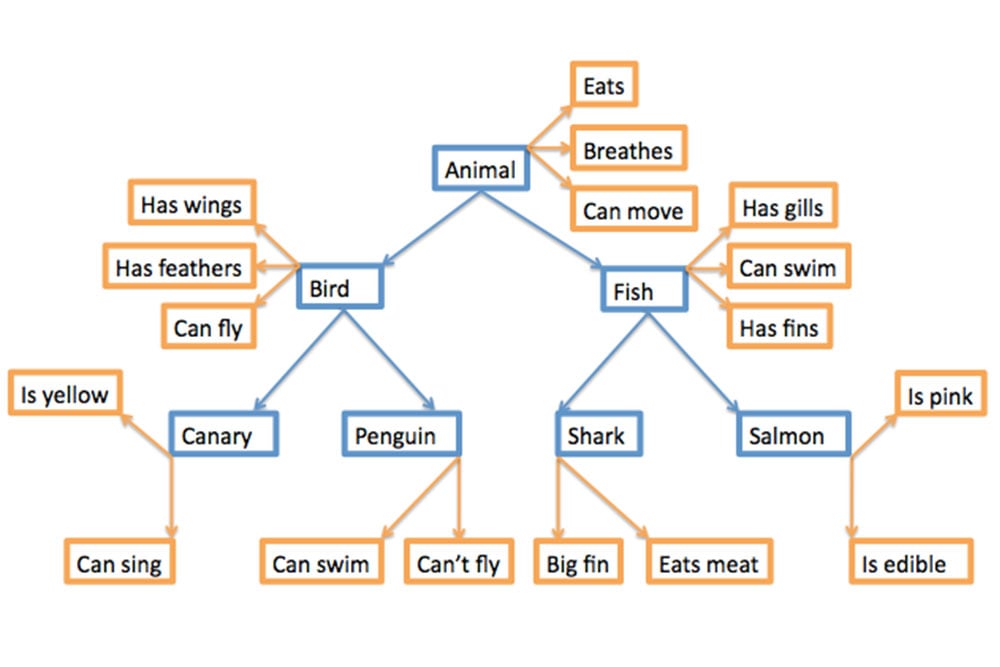On This Page:
Semantic memory is a type of long-term memory that stores general knowledge, concepts, facts, and meanings of words, allowing for the understanding and comprehension of language, as well as the retrieval of general knowledge about the world.
Key Takeaways
- Semantic memory is a long-term memory category involving the recollection of ideas, concepts, and facts commonly regarded as general knowledge. Examples of semantic memory include factual information such as grammar and algebra.
- Semantic memory differs from episodic memory in that while semantic memory involves general knowledge, episodic memory involves personal life experiences.
- There is much debate concerning the brain regions at work in semantic memory functions.
- While a semantic network graphically represents relationships between various concepts, semantic satiation refers to a phenomenon wherein repetition results in the temporary loss of meaning.

Semantic memory is a type of long-term declarative memory that refers to facts, concepts and ideas which we have accumulated over the course of our lives (Squire, 1992).
Semantic memory generally encompasses matters widely construed as common knowledge, which are neither exclusively nor immediately drawn from personal experience (McRae & Jones, 2013).
Examples of Semantic Memory
- Recalling that Washington, D.C., is the U.S. capital and Washington is a state.
- Recalling that April 1564 is the date on which Shakespeare was born.
- Recalling the type of food people in ancient Egypt used to eat.
- Knowing that elephants and giraffes are both mammals.
History and Background
The concept of semantic memory was first theorized in 1972 by W. Donaldson and Endel Tulving. Primarily influenced by the efforts of Scheer and Reiff (1959) to draw a distinction between the two primary forms of long-term memory, Tulving sought to distinguish episodic memory from what he would later call semantic memory.
Tulving (1972, p. 386), in his book Episodic and Semantic Memory, employs the word semantic to describe a system of memory that involves “words and verbal symbols, their meanings, and referents, the relations between them, and the rules, formulas, or algorithms for influencing them.”
Tulving (1984) further differentiated semantic memory and episodic memory based on their mode of operation, the type of information they process, and their application to the actual word and the memory laboratory.
What Research Suggests
Since Tulving’s proposal, many experiments and tests have been conducted to ascertain the veracity of his hypothesis.
For instance, a study was conducted in 1981 by Jacoby and Dallas using 247 undergraduate students as their subjects. The experiment involved two phases with perceptual identification and episodic recognition tasks.
Jacoby and Dallas utilized the experimental disassociation method, and the results of the study demonstrated a manifest distinction in performance between the semantic and episodic tasks, thereby supporting Tulving’s hypothesis.
The development of functional magnetic resonance imaging and positron emission tomography has enabled the exploration of various hypotheses related to semantic memory’s neural work organization (Eiling, Chrysikou & Thompson-Schill, 2013).
For instance, these neuroimaging methods can reveal the brain activity of individuals engaging in various cognitive tasks ranging from matching pictures to naming objects.
These new developments imply that semantic memory comprises several anatomically and functionally different systems and that no specific region in the brain plays a privileged role in retrieving or representing semantic knowledge.
Moreover, each attribute-specific system herein is joined to a sensorimotor modality as well as certain related properties within the modality.
Additionally, studies of neuroimaging suggest that semantic memory could be categorized into types of visual information such as motion, form, size, and color.
For instance, Thomson-Schill (2003) has postulated that the knowledge of motion and size is retrieved by the left lateral temporal cortex and the parietal cortex respectively, while the knowledge of form and color is retrieved by the bilateral or the left ventral temporal cortex.
Furthermore, networks of premotor cortex, parietal cortex, and ventral and lateral temporal cortex seem to constitute semantic representations that are distributed and organized by category and attribute.
This does not, however, rule out the possibility that nonperceptual conceptual knowledge may be represented under the more anterior regions of the temporal cortex.
While lexical retrieval may be tied to the posterior language regions, semantic processing within the temporoparietal network may be joined to the anterior temporal lobe.
Episodic vs Semantic Memory
Semantic memory is focused on facts, ideas, and concepts. Episodic memory, on the other hand, refers to the recalling of particular and subjective life experiences.
While semantic memory embodies information generally removed from personal experience or emotion, episodic memory is characterized by biographical experiences specific to an individual.
Hence, the latter involves actual events which had transpired at specific moments in one’s life.
| Semantic Memory | Episodic Memory |
|---|---|
| General knowledge | Personal experiences |
| Facts, concepts, meanings | Specific events and episodes |
| Objective and impersonal | Subjective and personal |
| Not tied to a specific time or place | Temporal and contextual details |
| Shared and common across individuals | Unique to an individual’s experiences |
| Used for understanding language and concepts | Used for remembering autobiographical events |
| Less susceptible to degradation or forgetting | More susceptible to degradation or forgetting |
| Examples: knowing the capital of a country, understanding mathematical concepts | Examples: recalling a specific birthday celebration, remembering a vacation trip |
Semantic memory refers to general knowledge and facts, while episodic memory involves personal experiences and specific events tied to a particular time and place.
Semantic Network
A semantic network is a cognitively based graphic representation of knowledge that demonstrates the relationships between various concepts within a network (Sowa, 1987). A taxonomic hierarchy may order the organization of a semantic network’s arcs and nodes.
A node is a symbol that represents a specific word, feature, or concept, whereas an arc is a symbol that stands for a two-place relationship between nodes (Arbib, 2002). Unlike neural networks, semantic networks are unlikely to use distributed representations for concepts.

A semantic network can be either a directed or an undirected graph (Sowa, 1987). While the vertices therein would represent concepts, the edges would stand for the semantic relations between the concepts.
These edges would be connecting or mapping various semantic fields. Models of logical comprehension and discourse, and artificial intelligence often portray semantic networks (Barr & Feigenbaum 1982).
Moreover, spreading activation invariably characterizes a semantic network’s processing (Arbib, 2002). Spreading activation is the act whereby the activation of one node results in the activation of other nodes via their interconnecting links (Collins & Quillian, 1972).
Certain natural language processing applications, such as word-sense disambiguation and semantic parsing, employ semantic networks (Hoifung & Domingos, 2009; Sussna, 1993).
Semantic Satiation
Semantic satiation refers to a situation wherein the repetition or an extended assessment of a phrase or word results in the temporary loss of its meaning to someone who views that word or phrase as meaningless (Das, 2014).
Semantic satiation was first introduced as a term in 1962 by Leon James Jakobovits, who demonstrated how various cognitive exercises can yield semantic satiation via several experiments.
According to Jakobovits (1962), verbal repetition arouses in the cerebral cortex a neural pattern that corresponds to the word’s meaning. Rapid repetition, which enables the repeated firing of central neural activation and peripheral sensorimotor activity, results in reactive inhibition which reduces the activities’ intensity with each repetition.
Examples of semantic satiation include the following:
- Repeating words verbally and then grouping them into ideas
- Rating figures which are shown repeatedly within a short time
- Repeating a set of numbers aloud and adding them soon afterward
Furthermore, semantic satiation has been integrated into the treatment of phobias via the use of specific cognitive activities to alter behavior through systemic desensitization (Jakobovits, 1966). Moreover, the use of repetition to induce semantic satiation to address negative emotions associated with speech is known to reduce speech anxiety.
Additionally, research has demonstrated the potential value of semantic satiation as a tool to better understand word learning, effective reading, and multilingualism (Fishman, 2014; Tian & Huber, 2010).
Brain Regions Related to Semantic Memory
The neuroscience behind semantic memory has long been a subject of debate. There are many clinicians and researchers who hold that brain systems which store semantic memory are the same that store episodic memory (Vargha-Khadem, 1997).
According to this view, the hippocampal formation and the medial temporal lobes are viewed as playing a vital role in storing semantic memory. This proposition holds that while the hippocampal formation enables the formation of memories by encoding them, the cortex stores the encoded memories.
This hypothesis additionally suggests that because the hippocampal formation includes not merely the hippocampus but also the entorhinal cortex and the perirhinal cortex, which constitute the para-hippocampal cortices, the encoding of information may be physiologically based outside the hippocampus itself.
Support for this theory stems from a study of amnesiacs who managed to demonstrate intact semantic memory despite damage to their hippocampus. The para-hippocampal cortices of these subjects had been spared.
Contrary to the above view, however, some researchers hold that semantic memory resides in the temporal neocortex, while some others hold that it is distributed across all brain regions (Vargha-Khadem, 1997) (Binder & Desai, 2011).
The second group, for instance, holds that the memory of a dog may stem from both the visual cortex and the auditory cortex. While a dog’s bark may have registered in the latter, a dog’s visual features may have entered the former.
References
Arbib, M. A. (Ed.). (2002). Semantic networks. In The Handbook of Brain Theory and Neural Networks (2nd ed.) . Cambridge, MA: MIT Press.
Barr, A., & Feigenbaum, E. A. (1982). The handbook of artificial intelligence. Lost Altos, CA: William Kaufman.
Binder, J. R., & Desai, R. H. (2011). The neurobiology of semantic memory. Trends in cognitive sciences, 15(11), 527–536.
Collins, A. M., & Quillian, M. R. (1972). How to make a language user. In E. Tulving & W. Donaldson (Eds.), Organization of memory (pp. 309-351). New York: Academic Press.
Das, J. P. (2014). Verbal Conditioning and Behavior. Oxford: Pergamon Press, Ltd.
Fishman, J. (2014). Advances in the Study of Societal Multilingualism. The Hague: Mouton Publishers.
Jacoby, L. L., & Dallas, M. (1981). On the relationship between autobiographical memory and perceptual learning. Journal of Experimental Psychology: General, 110 (3), 306
Jakobovits, L. A. (1966). Utilization of semantic satiation in stuttering: A theoretical analysis. Journal of Speech & Hearing Disorders, 31(2), 105–114.
Jakobovits, L. (1966). Semantic Satiation and Cognitive Dynamics (PDF). U.S. Department of Education.
Klein, S. B. (2013). Episodic Memory and Autonoetic Awareness. Frontiers in Behavioral Neuroscience, 7 (3), 1–12.
Jakobovits, L. A. (1962). Effects of repeated stimulation on cognitive aspects of behavior: Some experiments on the phenomenon of semantic satiation (Doctoral dissertation, McGill University Libraries).
McRae, K., & Jones, M. (2013). Semantic Memory. In Reisberg, Daniel (ed.). The Oxford Handbook of Cognitive Psychology. New York, NY: Oxford University Press.
Hoifung, P., & Domingos, P. (2009). Unsupervised semantic parsing. Proceedings of the 2009 Conference on Empirical Methods in Natural Language Processing. In Proceedings of the 2009 Conference on Empirical Methods in Natural Language Processing.
Reif, R., & Scheerer, M. (1959). Memory and Hypnotic Age Regression: Developmental Aspects of Cognitive Function Explored Through Hypnosis. New York, NY: International Universities Press.
Sowa, J. (1992). Semantic networks. In Shapiro, S. (Ed.) Encyclopedia of Artificial Intelligence ., 2nd edition, Wiley.
Squire, L (1992). Declarative and Nondeclarative Memory: Multiple Brain Systems Supporting Learning and Memory. Journal of Cognitive Neuroscience, 4 (3), 232–243.
Sussna, M. (1993, December). Word sense disambiguation for free-text indexing using a massive semantic network. In Proceedings of the second international conference on Information and knowledge management (pp. 67-74).
Thompson-Schill, S.L. (2003). Neuroimaging studies of semantic memory: inferring “how” from “where” . Neuropsychologia, 41 (3): 280–292.
Tian, X., & Huber, D. E. (2010). Testing an associative account of semantic satiation. Cognitive Psychology, 60 (4), 267–290.
Tulving, E. (1972). Episodic and semantic memory. Organization of memory, 1, 381-403.
Tulving, E. (1984). Precis of elements of episodic memory. Behavioral and Brain Sciences, 7 (2), 223-238.
Vargha-Khadem, F., Gadian, D. G., Watkins, K. E., Connelly, A., Van Paesschen, W., & Mishkin, M. (1997). Differential effects of early hippocampal pathology on episodic and semantic memory. Science, 277 (5324), 376-380.
Yee, E., Chrysikou, E. G., & Thompson-Schill, S. L. (2013). Semantic Memory. The Oxford Handbook of Cognitive Neuroscience. New York, NY: Oxford UP.


